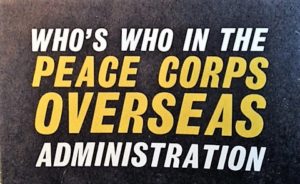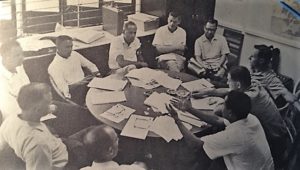Philippines’s First Peace Corps Staff (Part Two)
 Harris Wofford, the principal founder of the Student Federalists, had been the organization’s first president. Fuchs, then a student at New York University, followed tradition when he became president by interrupting his studies to spend one year traveling and speaking. He had already postponed his college work once before, when he served a wartime stint in the Navy Hospital Corps.
Harris Wofford, the principal founder of the Student Federalists, had been the organization’s first president. Fuchs, then a student at New York University, followed tradition when he became president by interrupting his studies to spend one year traveling and speaking. He had already postponed his college work once before, when he served a wartime stint in the Navy Hospital Corps.
But he had his Phi Deta Kappa key in 1950 when, at the age of 23, he graduated with honors in political science. Five years later, he received his Ph.D. from Harvard, three years after he had already joined the faculty at Brandeis University.
By 1959, Dean of Faculty at Brandeis, he had already written two books, The Political Behavior of American Jews and a lengthy social and political history of Hawaii entitled Hawaii Pono. As an activist as well as a theoretician inn politics, Fuchs was receptive to the call from the Peace Corps which came early in 1961.
Fuchs signed aboard in July; in the last of August, he left for the Philippines to prepare for the October arrival of the first Volunteers.
While still in Washington, Fuchs had collaborated in the selection of his deputy and his first associate representatives. Accompanying him on his August 31 arrival in the Philippines was his Deputy Representative, A. Paul Hare, Jr. who had taken a year’s leave from his regular job as associate professor of sociology and anthropology at Haverford College.
Fuchs and Hare set up Peace Corps headquarters in the AID building preparatory to finding permanent and separate quarters. In late December, the office was moved to a two-story building on Calle Herran in the south end of Manila—the building had formerly served as the local office for the makers of Peter Paul Mounds, and it was remodeled to accommodate a small hostel on the second floor for transient Volunteers. But before this move was made, the first three Associate Representatives arrived—Lawrence Howard on September 11, William Warren on September 21 and Harvey Pressman on September 28.
Pressman had studied under Fuchs at Brandeis and Howard had been a colleague on the political science faculty. After receiving his B.A. in 1958, Pressman had gone on to graduate study at Harvard. He remained in Manila for a little less than a year before returning to Harvard and his uncompleted Ph.D. studies.
Howard had studied at Drake (B.A.), Wayne University (M.A.) and Harvard, where he took his Ph.D. in political science with emphasis on African national movements. He joined the faculty at Hofstra College for two years before accepting an appointment as a professor of politics at Brandeis.
Warren graduated from Rensselaer Polytechnic in management engineering before taking a master’s degree in personnel services at Colorado State. He, too, went on to Harvard, in the graduate school of education, to seek a Ph.D.
The new associates scarcely had time to settle themselves before Columbus Day, 1961, when the first group of 127 Volunteer (Philippine I) poured off a plane at Manila International Airport. This first continent of Volunteers to arrive in the Far East had spent the summer in training at Pennsylvania State University and were not ferried to the Los Banos campus of the University of the Philippines for in-country orientation.
They were then sent out to schools in the Bicol region of southern Luzon and the Western Visayan island of Negros.
Their departure triggered a decision by Fuchs and his colleagues—effective administrative control of the program could only be assured by assigning the representatives on a regional basis.
Warren was sent to Legaspi in the Bicol where he set up a Peace Corps office looking out on the curve of Albay Gulf which bends around to the foot of the spectacular, symmetrical volcano, Mt. Mayon. Howard was sent to Dumaguet on the southern tip of Negros Island.

Conference in Cebu City–clockwise from Dr. Jack Harkness in lower left center: Cort, Modine, Gualberto, Pomento, Fuchs, Dey, Emanuel Escuderp. Warren. Flather. Howard.
Research Document: Who’s Who in the Peace Corps Overseas Administration (1963)
The photographs are by Rowland Scherman, Paul Conklin and Jim Walls, first photographers for the agency.
No comments yet.
Add your comment